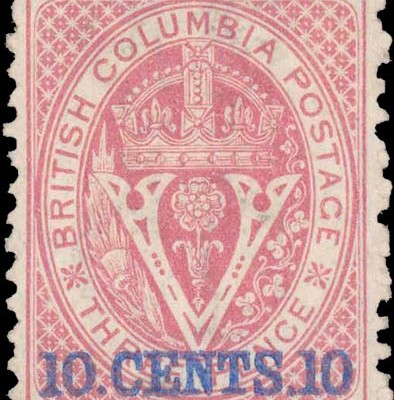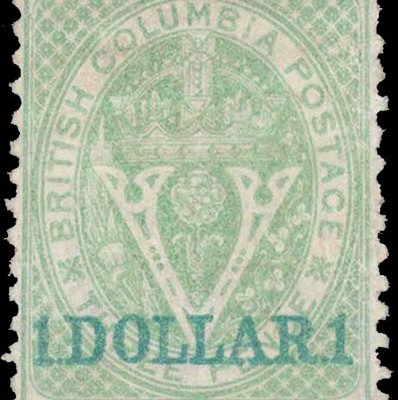Forged Stamps of British Columbia
“Album Weeds”
by R. B. Eareé
1865. British Columbia
3d. Blue
Genuine
Very nicely engraved, in épargne, on surfaced, white wove paper, watermarked with Crown and CC; machine-perforated 14. On each of the side-arches of the crown there are six small, white pearls, and four on the central arch. The ornaments on the upper part of the crown are crosses pattée and fleurs-de-lys alternately; the Central cross pattée, at the base of the central arch, is a good deal lower than the points of the fleurs-de-lys on each side of it. There are two good-sized asterisks in the oval band, which serve as stops, to separate the name and the value from each other; and these asterisks have eight points; i.e., four large ones, with four small ones between them. The groundwork of the outer corners of the stamp is a sort of lattice-work, and, at all the places where the lattice-work lines cross each other, there are small, white, four-pointed stars, at the points of intersection. The V-shaped, middle part of the M of COLUMBIA does not come down level with the feet of the two upright legs of the M. The G of POSTAGE is a distinct G. The middle cross fattée has a small outlined triangle in each of the three white, triangular arms, following the outline of each triangle, very near the edge; and each of these outlined triangles is perfect. The circlet at the base of the crown contains six jewels, connected, each to each, with two parallel lines; the left-hand jewel is nearly round, but all the others are diamond-shaped. The spray of shamrock, on the right side of the large V, runs up very nearly as high as the O of POSTAGE; and there is a small, but perfectly distinct shamrock-leaf between the S of POSTAGE and the side of the crown. The top of the highest thistle-leaf runs up level with the middle of the H of BRITISH; it is very sharply pointed, as are also the two side-lobes of this leaf; but these two side-lobes do not come up higher than level with the second I of BRITISH. The top petal of the central rose has three vertical lines of shading in it; the right and left petals have each three horizontal lines of shading, and the bottom petals have each four oblique lines. Both the engraving and printing of this stamp have been very carefully done; and, consequently, every little detail shows with almost photographic clearness, very different from a slip-shod lithograph.
Third Forgery
This is a much later production than the other two, and is likely to be dangerous, as it is nicely got up. Carefully lithographed, on stout, yellowish-white wove paper, unsurfaced, no watermark, well perforated 13 1/2. The asterisks are like the genuine, i.e., with four long thick arms, alternating with four short thin ones; but the left-hand asterisk is not so well shaped as the other, having one of the large arms too short, and another not coming accurately to the center. The stars at the inter- sections of the lines of lattice-work are clumsy, fat, and with the points indistinct The V-shaped middle of the M of COLUMBIA comes down exactly level with the legs of that letter. The G of POSTAGE is a very distinct C. The top arm of the middle cross pattée has the outlined triangle in it (though the figure is hardly to be called a triangle), with the top line broken in the middle, and each of the outlined triangles in the side-arms lacks the vertical line, making each figure look like a v laid on its side (> <). There is no shamrock-leaf in the spray of shamrock, above the top of the right-hand side of the large V. The top of the thistle-leaf above the top of the left side of the large V has three lobes; they are all very blunt, and the highest point does not reach up to the level even of the bottom of the H of BRITISH. The three top petals of the rose are unshaded; the right lower one seems to have three lines of shading in it, and the left lower one has only one line.
First Forgery
Lithographed, on hard, rather thin, white wove paper.; slightly surfaced; no watermark; unperforated. On each of the side-arches of the crown there are five large white pearls, and three very small ones on the central arch. The top of the central cross pattée on the crown comes up level with the top point of the fleur-de-lys on each side of it. The asterisks in the oval band are six-pointed, and all the points are very nearly of the same size, though the right-hand asterisk is very badly shaped. There are no stars at the intersections of the lines of lattice- work. The V-shaped middle of the M of COLUMBIA very nearly touches the outline of the oval beneath it. There are seven jewels, all diamond-shaped, in the circlet of the crown; they are connected with each other by a single line. The part of the spray of shamrock above the large V has two curly tendrils, ending with knobs, but no leaf. The highest thistle-leaf shows four lobes above the left side of the large V, and the longest of these lobes does not come higher than level with the middle of the S of BRITISH. Each of the upper petals of the rose contains two lines of shading; the two lower ones have only one line in each. This forgery is not at all bad, as a whole, although there are so many differences between it and the genuine.
Second Forgery
This may possibly be a badly-done reprint from the worn stone of the first forgery. I do not think it is likely to deceive; it is generally in a whitish sky-blue, and has a washed-out appearance. It is lithographed, on rather hard, unsurfaced, white wove paper, no watermark, perf. 13 (the favorite gauge of the forgers). There are five large pearls in each side-arch of the crown, and three, very nearly as large, in the central arch. The top of the cross pattée is higher than the fleurs-de-lys, each side of it. The asterisks in the oval band have six points each; those in the left-hand one are rounder-looking than the others. There are no white stars at the intersections of the lattice-work, in the corners of the stamp. The three legs of the M of COLUMBIA are level with one another. There are seven diamond-shaped jewels at the base of it he crown, joined together by a single line; but the third jewel from the left has the line broken each side of it, so that it does not join the others. The portion of the shamrock-spray that comes above the right side of the large V is just like that of the first forgery. The thistle-leaf above the top of the left side of the V has four lobes, as in the first forgery; two of them are level with the I of BRITISH, and the other two are level with the middle of the S. There is a colored blotch or dot under the said S, which joins the base of it to the line below it; and there is a colored dot over the first limb of the U of COLUMBIA, in the white line above it. The shading of the petals of the rose consists of blotches, instead of lines.
1867-1869. British Columbia Surcharged
2, 5, 10, 25 & 50 Cents & $1
Genuine
These stamps are of exactly the same type as the genuine Threepence described above. Probably from motives of economy, when the change of currency from £ s. d. to dollars and cents was effected, and new stamps were required, the die of the 3d. was utilized for the six new values, by merely surcharging with the said new values, and printing the stamps in different colors. It will be remembered, then, that all these new values, though in different colors, are from the die of the 3d., blue, and therefore need no description. The colors and surcharges are:
- 2 c., brown and black
- 5 c., red and black
- 10 c., lake and blue
- 25 c., yellow and violet
- 50 c., violet and red
- $1, green and green
The surcharge on the 2 C. is TWO CENTS, the rest have CENTS, with a numeral and stop each side, as, for instance, 5 . CENTS . 5.
Fourth Forgery
Of this I have the 10 CENTS (sic) in rose and black, and the 1 DOLLAR (sic) in dark yellow-green and violet. At a distance, these forgeries look very well, and the 10 c. is almost like a typograph. Lithographed, on somewhat surfaced, white wove paper, no watermark, perf. 14 (the 10 C.) and perf. 11 (the 1 dollar). Many of the tests described for the other forgeries are covered by the postmarks in my copies, but the following will be found amply sufficient. The cross-bar of the A of POSTAGE is an unconnected, circular dot, as is also the central tongue of the E of that word, and the G has a thick, square lump for a tail. The instant and easiest test is the shape of the asterisks each side of the value, in the oval label. Each of them is a St. Andrew’s cross, with dots between the arms (><) The top of the T of THREE is not joined to the stem; and the cross-bar to the H of that word is an unconnected dot.
First Forgery
This is the first forgery of the 3d., but has the blot under the S of BRITISH, and the dot above the first limb of the U of COLUMBIA. I have the FIVE CENTS (sic), in orange and black; the TEN CENTS (sic), in vermilion and dark blue; the TWENTY-FIVE CENTS (sic), in sulfur yellow and black; and the ONE DOLLAR (sic), in green and black.
Second Forgery
Like the second forgery of the 3d.; poorly lithographed; unperforated, or pin-perf. 13; no watermark. I have only the FIFTY CENTS (sic), in violet and vermilion.
Third Forgery
The same as the third forgery of the 3d. I have only the 50. CENTS . 50, in violet and carmine, and the 1 DOLLAR I, in green and blue. In the 50 C. the word FALSCH is printed at the top, in tiny block letters, the color of the surcharge; and in the the word FALSCH ! with a note of exclamation, is printed at the top in capitals, the color of the surcharge. These two therefore are evidently German productions, but I do not know where they were made.
Country Index
British Columbia
Discuss
on Facebook
Discuss
on Google+
Contact
Stampforgeries.com



